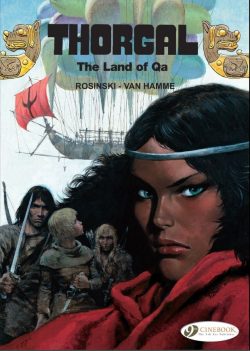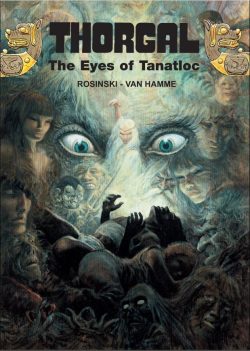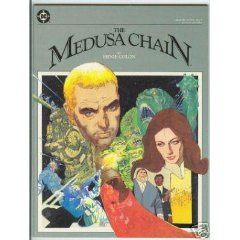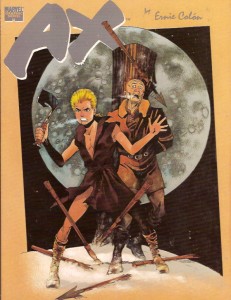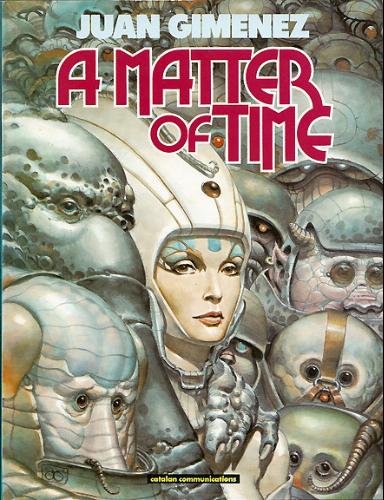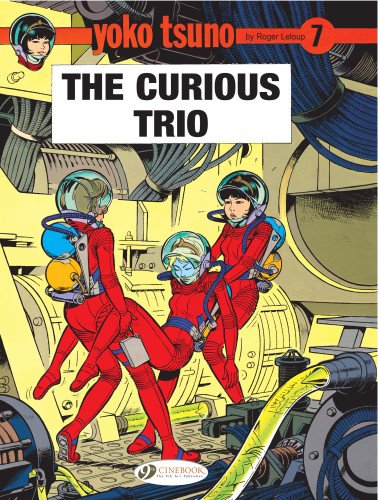
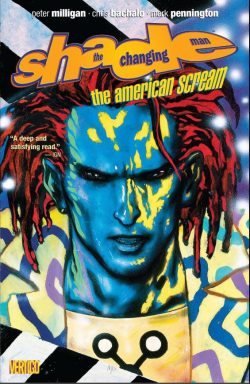
By Peter Milligan, Chris Bachalo, Mark Pennington & various (DC/Vertigo)
ISBN: 978-1-4012-0046-6 (TPB)
Even before DC hived off its “Mature Readers†sophisticated horror/hero series to become the backbone of the self-sustaining Vertigo line in 1993, the company had begun to differentiate between standard all-ages superhero sagas, new stand-alone concepts such as Gilgamesh II, Skreemer, Haywire or World Without End and edgy, off-the-wall, quasi-costumed fantasy and supernatural suspense titles as Doom Patrol, Black Orchid, Animal Man, Sandman, Hellblazer and Swamp Thing. Perhaps the most radical and challenging was a darkly psychedelic reworking of Steve Ditko’s lost masterpiece of modern paranoia Shade the Changing Man.
In the original 1977 mainstream series Rac Shade was a secret observer from the other-dimensional Meta-Zone. Framed for terrorism and sedition, he went rogue; using untried stolen technology to combat a wave of insanity that emanated from “the Area of Madness†within the Zero-Zone separating his world from ours. Said madness threatened both universes and Shade was resolved to stop it, despite the best efforts of sinister self-serving forces from Earth and Meta determined to destroy him.
When Peter Milligan, Chris Bachalo & Mark Pennington began to rework the character, much of Ditko’s original concept remained but was brutally tweaked for the far more cynical and worldly readers of the Blank Generation…
This collection – available in old-fashioned trade paperback and almost otherworldly digital formats – re-presents the first six issues of the new Shade from July to December 1990 and begins by introducing deeply disturbed Kathy George, patiently awaiting the final sanction on spree-killer Troy Grenzer.
Years previously, the unrepentant psycho-killer butchered her parents – and almost her too – and when her black boyfriend tackled the knife-wielding manic the Louisiana police shot her saviour instead of the white assailant…
Now in the final hours before Grenzer finally sits in the electric chair on ‘Execution Day’, Kathy is experiencing wild hallucinations. That’s nothing new: following the deaths of everyone she’d ever loved, Kathy was committed to an asylum until her inheritance ran out. Then she was released, apparently “too poor to be crazy†anymore.
Becoming a thief and a grifter, she wandered America until a radio report informed her Grenzer was about to be put to death. Inexplicably, Kathy found herself heading back to Louisiana…
On Death Row, things aren’t going according to plan. Bizarre lights, strange visions and electrical phenomena interrupt the execution and, as a fantastic reality-warping explosion occurs, Grenzer’s body vanishes…
On a hillside overlooking the prison, Kathy is pursued by an animated electric chair and Grenzer materialises in her car – only he claims not to be the serial killer but Rac Shade: a secret agent from another dimension who left his own body in an otherworldly Area of Madness to mentally occupy the now-vacant corpse of the serial killer.
It isn’t the craziest thing Kathy has ever heard, and even if it isn’t true, at least she has a chance to personally kill the man who destroyed her life…
As the drive away together, insane things keep happening. Shade explains that his transition to Earth caused a rupture in the fabric of the universes – a trauma in Reality…
Slowly acclimatising, Shade explains his original body is clad in experimental technology and his “M-Vest†connects his subconscious to the chaos of the Madness zone. His job was to come here and stop a plague of materialised insanity threatening both worlds, but now he’s actually given it easier access to ours…
After a climactic struggle with her own ghosts and traumas, Kathy reluctantly agrees to help the semi-amnesiac Shade in his mission.
Meanwhile at a Mental Hospital, uncanny events culminate in a ghastly reordering of people and matter itself: a horrific nigh-sentient phenomenon dubbed “the American Scream†breaks through from somewhere else and threatens all life and rationality on Earth. With casual daydreams, flights of fantasy and vicious whims increasingly given substance and solidity, the government – well aware of the crisis – dispatched Federal Agents Stringer and Conner to investigate…
The quest proper begins as the fugitives from justice troll through the hinterlands of American Culture and its Collective Unconscious, ending up in Dallas where obsessed author Duane Trilby, determined to discover ‘Who Shot JFK?’, finds himself conversing with the tarnished martyr himself. As the murdered president returns to the scene of the crime, the city starts to literally unravel, with a giant idolatrous bust of the victim bursting through the tarmac of Dealey Plaza, incessantly screaming for answers…
The chaos affects Shade, as the last vestiges of Grenzer’s personality repossess the body they share, determined to at last add Kathy to his tally of victims, even as Agents Stringer and Conner – convinced she is connected to Grenzer’s abrupt disappearance from his own execution – follow her to Texas. With madness rampant, Shade and Kathy are drawn into Trilby’s materialisation of events, becoming JFK and Jackie, inexorably heading toward death in that open-topped car…
The measured insanity escalates in ‘All the President’s Assassins!’ as Trilby saves Shade/JFK and slowly reveals his own personal tragedy: one which drove him to solve an impossible conundrum and avoid an agonising admission…
All the while, the Metan’s consciousness is being dragged into a succession of traumatised participants before realising he must defeat this outbreak of the American Scream quickly or surely fragment and die…
Escaping into his own past on Meta in ‘Mad, Bad and Dangerous to Know’, Shade physically re-experiences his early life, whilst in Dallas Stringer and Conner apprehend Kathy.
A lovelorn, impressionable poet, young dropout Rac Shade was tricked into becoming an agent and sent to Earth because it was apparently the source of devastating waves of insanity plaguing Meta, but en route he was sucked into the Area of Madness, meeting the American Scream face to face…
Falling back to Earth, Rac frees Kathy and they flee, arriving in Los Angeles in time to struggle with the dark underbelly of the film industry as it comes to murderous, sadistic life and starts stalking the stars and moguls who create the vicious yet glorious land of dreams. First singled out are the cast and crew of in-production zombie epic Hollywood Monsters, who endure shame and career destruction as impossible film-clips of their deepest secrets and darkest transgressions manifest. Soon after, mutilations and deaths begin, before a psychedelic crescendo is reached in ‘Hollywood Babble On II’ with Shade and Kathy fighting their way through a physically-realised and highly biased history of Tinsel Town triumphs and travesties, before finally seizing control of the noxious narrative and beating the Madness at its own game…
Sporting a stunning cover gallery by Brendan McCarthy, this terrifying tome is darkly ironic and blackly comedic, whilst gripping and dripping with razor-edged social commentary. Shade, the Changing Man added a sparkling brew of sardonic wit to the horror and action staples of the medium and remains one of the most challenging and intriguing series in comics history. Check it out.
© 1990, 2003, 2009 DC Comics. All Rights Reserved.

